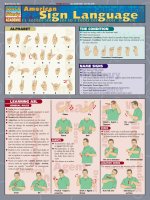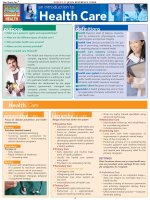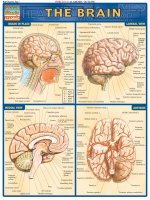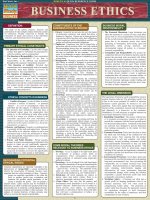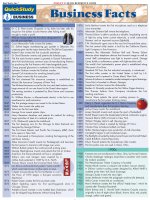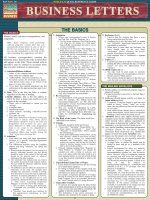BarCharts quickstudy psychology
Bạn đang xem bản rút gọn của tài liệu. Xem và tải ngay bản đầy đủ của tài liệu tại đây (394.87 KB, 4 trang )
BarCharts,Inc.®
WORLD'S #1 ACADEMIC OUTLINE
THE BASIC PRINCIPLES OF PSYCHOLOGY FOR INTRODUCTORY COURSES
INTRODUCTION
BIOLOGICAL BASES
LEARNING
OF PSYCHOLOGY
CONTINUED
• DEFINITION: Scientific study of behavior
and mental processes and how they are affected
by an organism’s physical and mental state and
external environment
• GOALS: Describe, understand, predict and
control (or modify) behavior or mental processes
• PSYCHOLOGY AS A SCIENCE:
1. Descriptive studies - describe but not explain
a. Case history - description of one individual
b. Observation
i. Naturalistic - natural environment
ii. Laboratory - setting controlled by researcher
c. Surveys - questionnaires and interviews
d. Tests i. Reliability - used to measure whether individual
differences in test scores are due to actual differences in
the characteristic being measured or due to chance
errors and fluctuations
ii. Validity - refers to the extent to which a test measures
what it purports; the validity of a test must be
empirically established – relating the test to particular
criterion that it claims to measure
2. Correlational Studies - strength of relationships
between variables, does not show causation
3. Experiment - researcher controls variable(s) to
discover its effect on other variables
a. Independent variable - manipulated/controlled by
researcher
b. Dependent variable - measured by researcher (data)
c. Experimental and control groups - only
experimental group exposed to independent variable,
otherwise treated the same
d. Change in dependent variable caused by independent
variable, since all else remained the same
e. Confounding Variable - an observed effect that may
be due to an intervening third variable between the
dependent and independent variables; the
confounding variable must be systematically
controlled or, if possible, eliminated, otherwise
obtained results are invalidated
f. Inferred Variable - a non-observable variable that is
inferred as the mediator between two observed
events; for instance, inferring the experience of "fear"
from certain measurable physiological anxiety
responses; it is frequently difficult to avoid circular
explanations in positing an inferred variable
g. Subject Variable - a condition that is part of the
subject’s make-up and cannot be assigned randomly;
e.g., sex, height, hair-color etc; because of their nonrandomnizability, causal conclusions cannot be
derived from subject variable experiments
h. Non-Subject Variable - a characteristic that is not
part of a subject’s make-up, and thus can be randomly
assigned; e.g., whether the subject received a certain
drug or a placebo
LEARNING
Change in behavior as a result of experience
• CLASSICAL CONDITIONING
1. Pavlov’s studies
a. Unconditioned stimulus (UCS) - food - elicits an
unconditioned response (UCR) - salivation
b. Pair neutral stimulus - tone - with UCS - food
c. Neutral stimulus becomes conditioned stimulus (CS)
- tone - which elicits conditioned response CR salivation
2. Principles of classical conditioning
a. Extinction - when the CS is not presented with the
UCS, it will diminish
b. Stimulus generalization - similar stimuli may elicit
the same response as the CS
c. Stimulus discrimination - different responses are
made to stimuli which are similar to the CS
• OPERANT CONDITIONING
1. Reinforcer (reward) - increases
probability
response
a. Positive reinforcement - response followed by presentation
of reinforcing stimulus
b. Negative reinforcement - response followed by removal of
unpleasant stimulus
2. Punishment - stimulus that follows response
decreases probability response will occur
3. Principles of Operant Conditioning
a. Extinction - response no longer reinforced
b. Stimulus generalization - response will occur to
similar stimuli
c. Stimulus discrimination - responses do not occur to
different stimuli
d. Timing of reinforcers - the sooner a reinforcer or
punisher follows an action, the greater its effect
e. Schedules of reinforcement
i. Continuous reinforcement - a particular response is
always reinforced
ii. Intermittent reinforcement - reinforcing only some
responses
(a) fixed ratio (FR) - reinforcement after a fixed number of
responses, high rates of responding
(b) variable ratio (VR) - reinforcement after average
number of responses, very high, steady rates of responding
(c) fixed interval (FI) - reinforcement after fixed amount of
time, scalloped response pattern
(d) variable interval (VI) - reinforcement after a variable
amount of time, low, steady rate of response
f. Shaping - reinforce successive approximations to the
desired response
g. Chaining - a method of connecting responses into a
sequence of behaviors; at the end of the chain there
must always be a reinforcer; the chain is constructed
by beginning at the end and working backward; all
behaviors have to be previously conditioned into the
organism’s repertoire
• STRUCTURE OF THE NERVOUS SYSTEM
1. Central - brain and spinal cord
2. Peripheral - sensory and motor nerves which
transmit information
a. Somatic - control skeletal muscles
b. Autonomic - regulates internal organs and glands
i. Parasympathetic - conserves energy
ii. Sympathetic - expends energy
• COMMUNICATION WITHIN NERVOUS
SYSTEM
1. Neuron - basic unit of nervous system
a. cell body - keeps neuron alive
b. dendrites - receive information from other neurons
c. axons - send information to other neurons
d. myelin - insulates axon to enable information to be
transmitted faster
2. Communication between Neurons
a. Synapses - gaps between neurons
b. Message travels through axon to synaptic knob on
axon's tip
vesicles
open
and
release
c. Synaptic
neurotransmitter into synaptic gap
d. Neurotransmitter fits into receptor sites on
receiving dendrite, causing it to be more or less
likely to fire
• THE BRAIN
1. Hindbrain
a. Medulla, pons, reticular activating system, cerebellum
b. Responsible for reflexive, automatic behavior
2. Midbrain - information conduit
3. Forebrain
a. Thalamus - directs sensory messages
b. Hypothalamus - emotion and survival drives
c. Pituitary gland - controls many other endocrine glands
d. Cerebral cortex
i. Occipital lobes - vision
ii. Parietal lobes - sensory information
iii.Temporal lobes - process sounds
iv. Frontal lobes - motor movements
4. Two brain hemispheres
a. Each one controls opposite side of body
b. Left hemisphere dominant for most people
4. Cognitive Behavior Modification
The principles of learning theory are applied to
alter undesirable thoughts, rather than only
observable behaviors
a. Social Learning Theory - (Bandura) four processes
which influence learning are:
STRESS AND
HEALTH
• STRESS - EMOTIONAL AND PHYSICAL
RESPONSES TO STIMULI
1. Caused by stimuli and the way those stimuli are
perceived
2. Biological reaction
i. Attention
ii. Memory
iii.Behavior
iv. Motivation
b. Specific cognitive processes that are recognized:
i. Attribution
ii. Expectancy
iii.Logical
iv. Verbal
v. Imaginable
a. Fight or flight - increase heart rate, breathing, tense muscles
b. Increased activity in the sympathetic nervous system
c. Adrenal glands secrete epinephrine (adrenalin) and
norepinephrine
3. Coping with stress
a. Reappraise situation
b. Maintain control over the stressful situation
c. Rational emotive therapy - (Ellis) considers the
central core of dysfunctional behavior to be due to
irrational beliefs; the therapy focuses on the
alteration of these irrational beliefs
d. Problem-solving therapy - focuses on enhancing the
patient’s ability to make decisions and solve problems
in stressful or difficult situations
e. Paradoxical intervention - patients are instructed to
purposely perform undesirable symptomatic
behaviors on command in an effort to demonstrate
their ability to gain control over these behaviors
f. Attribution therapy - attempts to facilitate the
patient’s ability to re-attribute undesirable feelings
and symptoms to something less threatening and
more acceptable
1
• PSYCHOLOGY AND ILLNESS
1. Heart disease
a. Type A personalities - hard-working, competitive,
increased incidence of heart disease
b. Type B personalities - easy going
2. Cancer
a. Exposure to carcinogens increases the risk
b. Psychological factors influence functioning of
immune system
• HEALTH AND SOCIAL RELATIONSHIPS
1. Friends - assisted coping
a. Emotional, cognitive and tangible support
b. Cultural differences in the value placed on friendships
2. Friends as stress producers
a. Contagion effect - others can exaggerate stress
b. Friend under stress can increase your stress level
c. Burden of caring for others can increase stress
SENSATION AND
PERCEPTION
• SENSATION - Awareness of physical changes
• MEASURING SENSATION
1. Absolute thresholds - detection of
percent of time
2. Difference thresholds (j.n.d. - just
difference)
signal 50
noticeable
a. Difference in sensation detectable 50 percent of time
b. Weber’s Law - change necessary for j.n.d. is a
proportion of original stimulus
• THE EYE
1. Light enters through the cornea
2. Lens focuses light on the retina
3. Retina - at the back of the eyeball
a. Rods - respond to dim light
b. Cones - respond to color
c. Fovea - center of retina, contains only cones, site
where vision is sharpest
• THE EAR
1. Outer ear - collects sounds waves
2. Middle ear - waves strike eardrum which passes
them to three tiny bones which intensify the force
of the vibrations
3. Inner ear - contains receptor cells (hair cells)
located within the cochlea which initiate nerve
impulses which travel to the brain
• TASTE
1. Four basic tastes - salty, sour, bitter and sweet - each
associated with different receptors or taste buds
• SMELL
1. Receptors in mucous membrane of nasal passage
• SKIN SENSES
and
1. World seen as constant, although the sensations
may change
2. Needs, beliefs, emotions and expectations all
influence perception
LANGUAGE,
THINKING AND
INTELLIGENCE
• LANGUAGE - Rule-governed system of
symbols used to represent and communicate
information
1. Understanding language
a. Phonology - knowledge of sounds
b. Semantics - knowledge or word meanings
c. Syntax - knowledge of grammatical structure
i. Deep structure - meaning
ii. Surface structure - organization of words
d. Psycholinguistics - the study of the ability to
produce and understand language
2. Acquiring language
a. Rules and strategies are innate
i. Basic timing and sequence of language development is
similar across cultures
ii. Children learn the rules of their native language, (i.e.,
overgeneralization)
b. Particular language acquired is based on experience
3. Language and thought - language has an impact on
how easily we process information
• THINKING
1. Using concepts - apply past experiences to present
thoughts
a. Concept - a mental grouping of a set of objects or
events on the basis of important common features
b. Must be learned through definition or example
c. Concepts aid in predicting and interpreting events
and organizing experiences
2. Problem solving - set of information used to
achieve goal
a. Strategies
i. Define the problem
ii. Use algorithms (systematic methods guaranteed to
produce a solution) or
iii.Use heuristics (a rule that may or may not produce a
solution), (i.e., simplification, reasoning by analogy)
b. Insight - sudden understanding of solution
• INTELLIGENCE - capacity to acquire and
use knowledge
1. Measuring intelligence
a. Binet - IQ tests - mental age (as determined by a test)
divided by chronological age = IQ
b. Wechsler - tests include verbal, mathematical and
nonverbal thinking skills
c. Average score is 100, scores describe a bell-shaped
(normal) distribution
d. I.Q. (Intelligence Quotient) is computed by dividing
a person’s "mental age" by their "chronological age"
and multiplying by one hundred; yielding the
formula: IQ = (MA/CA) X 100
2. Uses of IQ tests
a. As a predictor of school success
b. Concerns about being "culture fair"
3. Nature of intelligence - one ability or many?
4. Influence of the environment
a. Hereditability - studies over a forty-year span have
revealed 50 – 80 % genetic component to IQ.
Consequently, the general conclusion seems to be
that heredity has a substantial effect on IQ scores,
with at least half the observed variation in IQ scores
attributable to genetic differences
b. Experience determines point within genetic range
5. Extremes in intelligence
1. Touch (pressure), warmth, cold and pain
• PERCEPTION
organization
interpretation of sensations
LANGUAGE, THINKING
AND INTELLIGENCE
CONTINUED
a. Intellectually Challenged - IQ below 70
SOCIAL
PSYCHOLOGY
• ROLES - A social position governed by
norms
1. Norms - conventions by which we live
2. Zimbardo’s Prison Study
a. Students assigned to "guard" or "prisoner" roles
b. Student behavior reflected their assigned roles
3. Milgram’s Obedience Study
a. Participants thought they were part of an
experiment in learning
b. "Teacher" was instructed to shock "learner" for
wrong answer
c. Majority of "teachers" complied with the
instructions to administer shock
• SOCIAL COGNITION - how the social
influences
thoughts,
environment
perception and belief
1. Attribution - motivation to explain behavior
a. Situational - caused by the environment
b. Dispositional - caused by something within
individual
c. Fundamental attribution error - overestimate
dispositional and underestimate situational
causes
d. Self-serving bias - use dispositional
attributions for good behaviors and situational
attributions to excuse our own behaviors
2. Stereotypes - summary impressions when all
members of a group share common traits
3.Attitude - a relatively enduring opinion
including both cognitive and emotional
components
i. Biologically based - Downs syndrome, fetal alcohol
syndrome
ii. Psychosocial - disease, malnutrition, lack of
intellectual stimulation
a. Attitudes and behavior influence each other
b. Cognitive dissonance - when an attitude and
behavior conflict, we are motivated to make
them consistent
b. Intellectually gifted - skills on one or more
intellectual domains
4. Prejudice - unjustif ied negative attitudes
toward a group
MEMORY
Ability to retain and retrieve information
• INFORMATION PROCESSING THEORY
1. Information must be encoded to be processed by
brain
a. Storage - retention of information
b. Retrieval - accessing information
2. Three memory systems
a. Sensory - literal copy of information - held for 1-2
seconds
b. Short-term
i. Limited capacity (7 + or - 2 items)
ii. Information held for about 30 seconds; then it is
forgotten or further encoded and placed in long-term
memory
c. Long-term
i. Unlimited capacity
ii. Information stored and retrieved by category
3. Forgetting
• CONFORMITY - behavior that occurs as
a result of real or imagined group
pressure
• OBEDIENCE - following orders from an
authority
• INDIVIDUALS AND GROUPS
1. Groupthink - tendency for all group
members to think alike and suppress dissent
2. Group Polarization - tendency of a group to
take a more extreme position than those of
individual members
3.Responsibility
a. Diffusion of responsibility - avoidance
b. Social loafing - individual slows down to let
the group shoulder the load
c. Bystander apathy will not occur when one
i. Perceives the need to help
ii. Decides to take responsibility
iii.Weighs the costs of helping
iv. Knows how to help
• LOVE - (Sternberg)
a. In sensory memory - through decay
b. In short-term memory
i. Limited capacity subject to “filling up”
ii. Can retain information through rehearsal
(a) Maintenance (rote) rehearsal
(b) Elaborative rehearsal - associating new with old
information
c. In long-term memory
i. Decay - information fades if not used
ii. Forgetting
(a) Interference - similar items interfere
(b) Motivated - conscious or unconscious “hiding” a
memory
(c) Cue-dependent - unable to gain access to the information
(d) Zeigarnik effect - interrupted, or incomplete tasks seem
to be better remembered than completed tasks
(e) Non-verbal memory - pictures are remembered
significantly better than words; motor memory seems to be
impervious to decay
2
1.Has three related components:
a. Intimacy
b. Passion
c. Commitment
2.Depending on the combination of these
elements, produces different dimensions in a
relationship:
a. Liking - intimacy alone
Love
intimacy
and
b. Companionate
commitment
c. Empty Love - commitment alone
d. Fatuous Love - passion and commitment
e. Infatuation - passion only
f. Romantic Love - intimacy and passion
g. Consummate Love - intimacy, passion, and
commitment
PERSONALITY
CONTINUED
DEVELOPMENT
• DEFINITIONS
1. Learning - influence of experience (nurture)
2. Maturation - unfolding of biological patterns (nature)
3. Critical Periods - early development periods during
which particular early experiences are essential
4. Stages - organization of behaviors and thoughts
during particular early periods of development defined by relatively abrupt change
2. Psychosexual development
• COGNITIVE DEVELOPMENT
3. Anxiety - unjustified fears resolved by ego through
use of defense mechanisms
1. Piaget
a. Assimilation - fit new information into what is known
b. Accommodation - change existing beliefs in
response to new knowledge
c. Stages of development
i. Sensory-motor stage (birth - 2) - object permanence
ii. Preoperational stage (2-7) - use of symbols and
language; egocentric; lack the principles of conservation
iii. Concrete operational stage (7-11) - understand
conservation, identity, grounded in concrete experiences
iv. Formal operations stage (12-adult) - abstract reasoning
2. Language development - acquisition depends on
biological readiness and experience
• SOCIAL DEVELOPMENT
1. Attachment - emotional tie between infant and
caretaker (Harlow’s monkey studies)
2. Sex typing - learning “masculine” or “feminine”
a. Identification with the same sex parent
b. Rewards and punishments for sex appropriate behavior
3. Erikson’s stages
a. Trust Versus Mistrust: 0 – 2 years of age
b. Autonomy Versus Doubt and Shame: 2- 3 years of age
c. Initiative Versus Guilt: 3 – 6 years of age
d. Industry Versus Inferiority: 6 – 11 years of age
• MORAL DEVELOPMENT - Kohlberg
Theory:
1. Preconventional morality - obey because ordered
to or will be punished
2. Conventional morality - based on trust, loyalty or
understanding social order
3. Postconventional morality - laws are situational
and can be changed
• CHRONOLOGICAL DEVELOPMENT
1. Newborn Child
a. Reflexes - automatic behaviors, rooting, sucking,
swallowing, startle, etc.
b. Vision - nearsighted, interested in novelty
c. Social skills
i. Smile at 4-6 weeks in response to faces
ii. Rhythmic "conversations"
2. Adolescence
a. Biological development - increased hormone
production; sex organs mature; growth spurt
b. Intellectual development - formal operational
(abstract reasoning), independence, questioning
3. Aging
a. Transition Theories - unanticipated, anticipated,
nonevent, chronic hassle
b. Major Milestones - starting out, marriage or living
alone, parenthood, empty nest, midlife crises,
retirement, widowhood
a. Oral stage (0-1) - sucking, feeding, etc.
b. Anal stage (2-3) - defecation
c. Phallic stage (3-5) - sexual attraction to the opposite
sex parent produces the Oedipus complex
d. Latency period (5-puberty) - sexual feelings
forgotten; child concentrates on skill development
e. Genital stage - adult sexual relationships
a. Repression - active exclusion of unconscious
impulses from consciousness
b. Projection - attribute to others our thoughts and feelings
c. Reaction formation - behavior patterns opposite to
our anxiety producing urges
d. Displacement - redirects anxiety producing
behaviors to a more acceptable target
e. Rationalization - substitute “good” reasons for real
reasons for behavior
4. Defense Mechanisms
a. Denial - the refusal to acknowledge an external
source of anxiety
b. Fantasy - utilizing imagination to satisfy desires that
are, in reality, highly unlikely (e.g., sexually
fantasizing about a celebrity)
c. Intellectualization - the repression of the emotional
component of an anxiety-provoking event; the event
is treated in a purely analytical manner
d. Regression - resorting to infantile behaviors as a
method for avoiding anxiety and/or responsibility
e. Identification - identifying with the anxietyproducing stimulus in an attempt to reduce one’s own
anxiety (opposite of projection)
f. Overcompensation - an attempt to conceal perceived
deficiencies in one area by excelling in another; e.g.,
a student with poor academic performance becomes
an excellent athlete
g. Sublimation - the re-channeling of sexual or
aggressive impulses in a socially acceptable
direction; e.g., an aggressive person becomes a
professional boxer
• HUMANISTIC THEORIES - people are
rational, capable of choice and desire to
achieve personal growth
1. Carl Rogers - self-concept directs behavior,
conflict between real and ideal self
2. Abraham Maslow - individual strives for selfactualization - fulfillment of potential
• EXISTENTIAL PSYCHODYNAMICS
1. Yalom - primary drive of the individual is to derive
meaning from the complexities of their life
experiences; to understand a structure, rationale, or
justification to the events they have experienced;
failing this, life is seen as absurd and pointless, leading
to despair, depression, and existential crises; the
primary concerns of this approach to psychotherapy
deal with confronting the issues of death, freedom,
existential isolation, and meaninglessness
• SOCIAL COGNITIVE THEORY - how and
under what situations thoughts and behaviors
are learned
• CONSISTENCY IN PERSONALITY
1. Trait - relatively enduring quality or characteristic
2. Cross-situational - most central to self-concept
• PERSONALITY ASSESSMENT
PERSONALITY
Distinctive patterns of behavior, thoughts and
emotions that characterize individual's
patterns of adaptation
• THE ORIGINS OF PERSONALITY
1. Biological and genetic influences
2. Experience - cultural and unique
3. Stability and change
a. Genetic characteristics relatively stable through life
b. Less active, hostile and impulsive with age
c. Personality changes as a result of life experiences
• FREUD
1. Personality consists of three parts
a. Id - basic biological urges; unconscious
b. Ego - gratifies urges within acceptable bounds; conscious
c. Superego - values and ideals of society; conscience
1. Assessment methods must be:
a. Reliable - same results over time
b. Valid - measure what it is supposed to measure
2. Interview
a. Advantage - tailored to individual's previous answers
b. Disadvantage - low reliability
3. Observation
a. times particular behavior occurs
b. Good reliability
4. Self-report
a. MMPI - to diagnose psychological disorders
b. Ten primary scales measure personality dimensions
5. Projective techniques - individual provides an
interpretation of ambiguous material
a. Rorschach inkblots
b. Thematic Apperception Test (TAT)
c. Concerns about reliability and validity since
interpretations are subjective
3
MOTIVATION AND
EMOTION
• MOTIVATION - need or desire to act a certain
way to achieve a goal
1. Range of motives
a. Physiological - hunger, thirst, pain avoidance
b. Social - learned
c. Maslow - motives organized in a hierarchy of needs physiological, safety, love and belonging, esteem,
self-actualization
2. Motivational system - set of motives and
behaviors that operate in a particular life area
a. Hunger and eating
i. Hunger signals - stomach contractions, hypothalamus,
environment
ii. Food preferences - cultural, personal and biological
origins
b. Sexual motivation - hormones
c. Work
i. Extrinsic motivation - working for external reward
ii. Intrinsic motivation - working for pleasure of activity
itself
3. Maslow’s hierarchy of motivations
a. In the hierarchy of needs, the needs at each level must
be satisfied before going on to the next level
b. The hierarchy of needs
i. Physiological needs - food, water, sex, and shelter
ii. Safety needs - security needs
iii.Belongingness and love needs - acceptance and
friendship
iv. Esteem needs - self-esteem, and esteem from others
v. Self-actualization needs - realizing one’s potential as a
creative, productive person
• EMOTION
1. Defining features of emotions - subjective
experience, physiological arousal, expressive
behavior, changes in cognition
2. Inborn - people from different cultural
backgrounds can identify emotions
3. James-Lange Theory - emotion is a result of a
perception of bodily changes and behaviors
4. Cannon-Bard Theory - emotion is a result of
perception of a stimulus which causes both
physiological changes and subjective feelings
5. Cognitive Labeling Theory - emotion is a result of
the interpretation of the causes of physiological
arousal
6. Frustration-aggression hypothesis - aggression
results from blocking of efforts to achieve a goal
CONSCIOUSNESS
• JAYNES’ THEORY
1. Consciousness not only evolves neurobiologically,
but is also formed by the individual’s interactions
with culture
2. The foundation of consciousness is based in the
physiology of the brain’s left and right hemispheres;
there are three fundamental forms of human
awareness that are the outcome of this process:
a. Bicameral - controlled by right hemisphere of brain,
which dominates left-hemisphere activity; individual
subordinates consciousness of self to control by a
group, a higher power, or other individual
b. Modern - the dominance of the right brain
hemisphere over the left is weakened as civilization
develops and humans become more autonomous and
independent; as humans become more independent,
individual consciousness emerges
c. Throwbacks to bicamerality - the re-emergence of
bicameral consciousness in modern life is manifested
by episodes of schizophrenia, hypnosis and poetic
and religious frenzy
• SLEEP RHYTHMS
1. REM - rapid eye movements associated with
dreaming
CONSCIOUSNESS
CONTINUED
2. Stages of brain waves
a. Alpha Waves - regular, high-amplitude, low
frequency wave
b. Stage 1 - small, irregular brain waves, light sleep
c. Stage 2 - bursts of sleep spindles
d. Stage 3 - delta waves; deep sleep
e. Stage 4 - extremely deep sleep
f. Entire cycle is 30-45 minutes and then reverses
• WAKEFULNESS
1. Conscious processes
2. Subconscious processes - can be brought into
consciousness when necessary
3. Nonconscious processes - remain outside
awareness but influence behavior
• ALTERED STATES
1. Meditation - eliminate distracting thoughts
2. Psychoactive drugs - influence perception,
thinking or behavior
a. Stimulants - speed up nervous system activity cocaine, amphetamines
b. Depressants - slow central nervous system activity alcohol, tranquilizers
c. Opiates - relieve pain and produce euphoria - opium,
morphine, heroin
d. Psychedelic drugs - alter consciousness - LSD,
mescaline
3. Hypnosis - heightened state of suggestibility when
subjects can sometimes control unconscious body
functions
4. Weil’s Theory
a. Humans have an innate drive to experience states of
non-ordinary consciousness
b. Individuals and cultures experiment with ways to
change their ordinary states of consciousness
c. Altered states of consciousness are common; e.g.,
daydreaming, sleeping, etc
d. Individuals often are unaware they are in the midst of
an experience of non-ordinary consciousness; e.g.,
daydreams, or alcoholic ‘black-out’ episodes
e. Altered states of consciousness form a continuum or
spectrum ranging from normal, alert, waking
consciousness to sensory deprivation, to coma
f. Psychotropic and psychedelic drugs do not cause
altered states of consciousness—they are merely a
way to elicit such states
g. Understanding the mechanisms of altered states of
consciousness can be an avenue to greater
understanding of the nervous system; furthermore,
such knowledge may lead to the discovery of
untapped human potential and a better understanding
of ordinary waking consciousness
ABNORMAL
BEHAVIOR
• TYPES
1. Statistical deviation
2. Violation of cultural standards
3. Maladaptive behavior
4. Emotional distress
5. Legal (impaired judgment and lack of self-control)
• ANXIETY DISORDERS
1. Generalized anxiety disorder - chronic anxiety
2. Phobia - fear of specific situation, activity or thing
3. Obsessive-compulsive disorder
a. Obsessions - recurrent thoughts
b. Compulsions - repetitive behaviors
• MOOD DISORDERS - (depression & mania)
1. Causes
a. Biological (brain chemistry)
b. Social (life situations)
c. Attachment (disturbed relationships)
d. Cognitive (maladaptive thoughts)
• PERSONALITY DISORDERS
1. Paranoid - excessive suspiciousness
2. Narcissistic - exaggerated sense of self-importance
3. Antisocial - lack of social emotions
• DISSOCIATIVE DISORDERS - amnesia,
multiple personality
• SOMOTOFORM DISORDERS - take the
form of physical disorders
• PSYCHOTIC DISORDERS
1. Schizophrenia - bizarre delusions, hallucinations,
severe emotional problems, withdrawal
a. Family dynamics - distorted patterns of communication
b. Biological - brain disease(s) or abnormalities in
neurotransmitters
c. Stress - combination of heredity and stress
2. Organic brain disorders - i.e. diseases, brain injury
• VIEWS ON THE REALITY OF MENTAL
ILLNESS
1. Szasz’s Objection - the concept of "mental illness"
is a socially constructed myth for the purpose of
advancing certain social and political agenda;
clinical psychology is an instrument of repression to
enforce conformity and stigmatize non-conformists
as "deviant" people with the label "mentally ill"
2. Reznek’s Definition - something is a mental
illness if, and only if, it is an abnormal* and
involuntary process that does mental harm and
should best be treated by medical means
*Note - "abnormal" is used in the constructivist or
normative sense, and not in the statistical or
idealistic sense, as "normal" is a relative term
determined by society
TREATMENT AND
THERAPY
U.S. $4.95 Can. $7.50
NOTE TO STUDENT: This QUICKSTUDY® guide is an outline of the major topics
taught in introductory Psychology courses. Due to its condensed format, use it as a
Psychology guide, but not as a replacement for assigned class work.
All rights reserved. No part of this publication may be reproduced or transmitted in any form, or by any means,
electronic or mechanical, including photocopy, recording, or any information storage and retrieval system, without
written permission from the publisher. © 2001 BarCharts, Inc. 1106
ISBN-13: 978-142320215-8
ISBN-10: 142320215-5
• MEDICAL TREATMENTS
1. Antipsychotic drugs (major tranquilizers) schizophrenia
2. Antidepressant drugs (stimulants) - mood
disorders
3. Surgery - to destroy brain areas believed
responsible for emotional disorders
4. Electroconvulsive therapy - induces seizures used
to treat major depression
• PSYCHOTHERAPY
hundreds of titles at
quickstudy.com
1. Psychodynamic (insight) therapies - explore the
unconscious dynamics of personality
a. Freud i. Understanding past produces insight
ii. Free association and transference
b. Neo-Freudians - use Freud’s techniques, usually time
limited
2. Behavioral therapies
Customer Hotline # 1.800.230.9522
a. Systematic desensitization - exposure to a hierarchy
of stimuli while relaxing to decrease fears
b. Aversive conditioning - punishment for unwanted
behavior
4
TREATMENT AND
THERAPY CONTINUED
c. Implosion - client required to imagine the anxietyproducing stimulus in its most vivid and extreme
manifestation; client experiences full anxiety
response without suffering any harm; consequently,
the stimulus no longer elicits anxiety due to
extinction of the response
d. Flooding - same procedure and theory as implosion,
but real or realistically depicted stimuli are used
instead of imaginary ones
3. Cognitive therapy - to correct unrealistic thinking
4. Humanistic therapy
a. Client-centered - Carl Rogers
i. build self esteem
ii. critical qualities of the therapist - warm, genuine and
honest
b. Gestalt - Frederick Perls - self-actualization
5. Family and Group therapies - theorize that
problems develop in a social context and must be
dealt with in that context
• EVALUATING THERAPIES
1. Therapies are less effective with serious disorders
2. Relationship between client and therapist is critical
3. Certain therapies are effective for certain specific
problems
• MEDICAL TREATMENTS
1. Advantages of Medical Model - promotes a more
humane understanding of patients; aids in the
understanding of some organic mental disorders
and further initiates research in brain function
2. Disadvantages of Medical Model - environmental
variables are unduly minimized or neglected;
diagnostic and treatment methods are questionable,
thus fostering an institutionalization syndrome; this
approach removes responsibility for recovery from
the patient while promoting a dependence upon
hospitals and chemicals
• BEHAVIORISM
1. Cognitive components to behavior (e.g.,
expectations, verbalization, imitation etc.) are
unduly minimized or ignored
2. Overly operationalistic - physical correlates are
closely identified with mental states (e.g., fear is
identified with the physiological manifestations of
anxiety); overlooks the possibility that the
interpretation of observable physical symptoms can
determine their reality; for instance, the physiological
correlates of anxiety may be interpreted as fear,
excitement, anger, or sexual arousal depending upon
prior expectations, cultural values etc
3. Ignores the role played by intervening inferred
cognitive variables
• COGNITIVE BEHAVIORISM
1. Difficult to avoid circular definitions in invoking
the meaning of certain mental constructs
2. Difficult to determine what extent to allow
decreasingly operationalizable mental entities
3. The role of psychosomatic variables may be
overlooked or minimized
4. Some argue that the underlying cause of observable
symptoms is ignored by behavioral therapies
Note - Clinically, both behaviorism and cognitive
behaviorism only seem effective in the treatment of
very specific disorders; e.g., phobias, specific
undesirable behaviors; cannot effectively be applied
to amorphous problems such as undifferentiated
existential depression
• PSYCHOANALYSIS
1. Freud’s initial theory based only on case studies
and anecdotal evidence, and a patient population
which was very limited, atypical, and selective
2. Postulates entities that are by definition
unobservable and cannot be operationalized for
valid scientific evaluation
3. Psychoanalysis has been demonstrated (by Eysenck)
to be ineffective in treating emotional disorders
4. In reaction to criticism and undermining evidence
against their theory, Neo-Freudians have modified
their theory with post-hoc hypotheses to the point that
it is no longer scientifically testable even in principle



